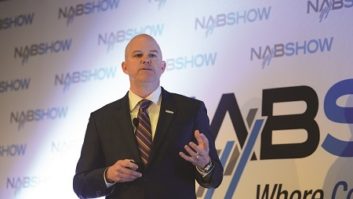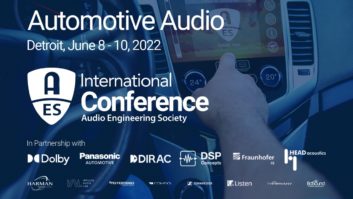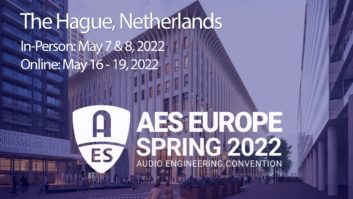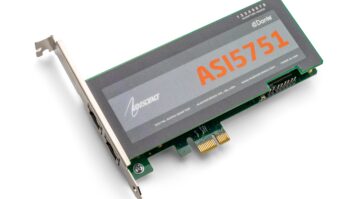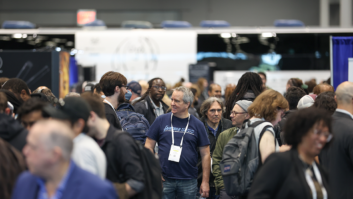
The 137th International AES Convention is next month, Oct. 9–12, in Los Angeles. Chairman of the Broadcast and Streaming sessions David Bialik has provided a gaggle of interesting sessions.
Two sessions guaranteed to be of interest to radio broadcasters attending are Oct. 9’s “Loudness for Streaming and Radio” and “Understanding Audio Processing — How to Use the Audio Processor” on Oct. 11.
LOUDNESS
Radio is famous for its “loudness wars,” or battles between stations processing their outputs to “sound” louder than the next station. But it has rarely come under the scrutiny that television has for seemingly uneven levels between stations, programming and commercials.
Now, as Internet streaming has become a bigger part of consumers’ audio diet, the topic is more under the microscope. Adding to the dilemma is the “hypercompression” of much of the material used to stream. With inconsistent source material, unpredictable bandwidth and bitrates and varying ISPs at delivery and reception, Internet audio can be more than a little uneven.
Thomas Lund, CTO for Broadcast and Production at TC Electronic, is moderating the loudness session. He says, “Today it’s difficult for the average consumer to access audio of even the quality we were used to from the cassette 30 years ago. Last month, TC’s switchboard operator, a woman in her 40s, heard a Bonnie Raitt CD track played in our studio. Even from a distance, she commented on the audio quality she hadn’t heard in a long time.”
He adds, “Sadly, there is a loudness problem in most streaming. However, there are also good guys that have been working to help turn the tide. Apple has been admirable, designing a decent loudness normalization system early. Add to that a well-chosen target level plus a reasonable audio infrastructure with digital optical coming out of most devices.”
Lund also notes, “Other relevant streaming initiatives are also emerging now, e.g. Tidal, but most are still audio-ignorant: YouTube, Spotify, Pandora, Google etc. Plus, of course, the immense amount of crappy-sounding Internet ‘radio’ stations broadcasting at a completely insufficient headroom of maybe 8–10 dB.”
Panelist Frank Foti, Omnia founder and head the Telos Alliance, has a thought-provoking angle: “This topic has been on the AES slate for a few years now. Loudness has become a topical debate over the last decade or so, due to the amount of hypercompression used in music production and mastering. The misnomer is that ‘loudness,’ per se, is getting a bit of a bad rap, in my view. The reason is that loudness is not the issue. It’s the ‘how’ it got to be loud that’s the challenge or annoyance. Audio can be loud and pleasing, believe it or not.”
AES BROADCAST AND STREAMING SESSIONS
Thursday, Oct. 9
• “Facility Design: To Move, or Not to Move? Contrasting Solutions — Two West Coast FM Stations Address Shifting Listener Needs,” 10:45 a.m.–12:45 p.m.
• “Loudness for Streaming and Radio,” 2:15–4:15 p.m.
• “Routing Audio in a Broadcast Facility,” 4:30–6 p.m.
Friday, Oct. 10
• “Audio Issues for 4k and 8k Television,” 9–10:30 am
• “The Streaming Experience,” 11:15 a.m.–12:30 p.m.
• “Listener Fatigue and Retention,” 2–3:30 pm
• “MPEG-DASH — What about Audio?” 3:30–5 p.m.
• “Audio Issues and HTML5,” 5– 6:30 p.m.
Saturday, Oct. 11
• “Sound Design and Storytelling: How to Create the Environments and Sounds Needed to Enhance Any Tale,” 9–10:30 a.m.
• “Compliance with CALM Act/PLOUD,” 10:30 a.m.– 12 p.m.
• “SBE/Troubleshooting and Maintenance of Equipment,” 12–1:30 pm
• “Understanding Audio Processing — How to Use the Audio Processor,” 2–3:30 p.m.
• “Audio Issues for Live Television — Overcoming the Challenges of Live Television Broadcast in Today’s Wild, Wild World,” 3:30–5 p.m.
• “Telephony and IP Codecs: How to Choose What Is Best for You,” 5–6:30 p.m.
Sunday, Oct. 12
• “Troubleshooting Software Issues,” 10:30 a.m.–12 p.m.
• “Society of Broadcast Engineers Exams,” 2–5 p.m.
There will also be interesting and topical sessions for broadcasters in many other session tracks, notably the Networked Audio and Recording & Production tracks. There will also be some guilty pleasure sessions such as those found in the Game Audio track. Check out www.aes.org/events/137.
In television, where the “loudness” problem has become a major issue, it is most readily apparent with commercials that appear to be much louder than the programming segments they are inserted between.
Also on the panel is fellow audio processing guru Bob Orban, who says, “A well-processed stream will not have the ‘loud commercial problem.’ The audio processor will equalize the loudness of the commercials and program elements so that they are well-balanced with each other and comfortably listenable. Radio broadcasters have used audio processing for this purpose pretty much forever.”
But, he adds, “Two main problems can arise. The first, underprocessing, can arise from purism or idealism, but in practice can result in annoying inconsistencies in loudness between program elements in a given stream. The second is large loudness inconsistencies when one switches between streams, although in well-processed streams, this requires that listeners readjust their volume controls only when they have switched streams, so it’s much less annoying than incessant loudness inconsistencies between program elements in a given stream.”
Orban notes that differing program/content sources may be part of the problem as they may process their material differently. “Another frequently encountered pitfall occurs in a ‘commercial replacement and insertion’ environment, where the inserted commercials may be processed differently than the surrounding program material. This can be fixed by processing the inserted material separately so that it has the same target loudness is the main program, or by inserting the commercials into the unprocessed program before the main audio processing is applied.”
LEGISLATION
Some might call for legislation, but Foti is skeptical.
“Legislation? C’mon, there’s no need for that! We already have it with TV in the U.S.A. with the CALM Act, and parts of Europe employ the ITU BS-412 MPX power limit on FM. I don’t feel a need for an industry group would be beneficial.”
He warns, “Most of those get mired down in bureaucracy and politics. I’m not sure there’s an efficient process that can be implemented to govern, if you will, something subjective as loudness. The marketplace can easily self-police itself.”
Orban agrees to some extent, “I don’t believe that legislation is practical because to be effective, it would have to be obeyed worldwide by netcasters in a heretofore unregulated environment. There would be an enormous amount of pushback against it, and it would be unenforceable. The only thing that the industry can do is to develop voluntary standards for target loudness.”

credit: Cbl62 / Wikimedia Commons / CC-BY-SA-3.0 But he has seen some constructive moves: “The PLOUD group in Europe has already done a great deal of work on standardization of loudness practices, so a new group does not need to be formed.”
Lund concludes, “Because of the loudness wars, time has actually gone backwards, rendered recent music heritage for more than a decade more or less unlistenable. That’s how this point in time will be looked back at. As professionals, we have an obligation to speak up because it’s happening right here, right now — on our watch.”
They will be joined by John Kean of National Public Radio, Tom Box of DTS and Scott Norcross of Dolby Labs.
A real treat is to be had at 2–3:30 p.m. on Oct. 11, when CBS Radio’s Tracy Teagarden gathers together Bob Orban, Frank Foti, Greg Ogonowski of Orban, Tim Carroll of the Telos Alliance, Jean-Marc Jot of DTS and Sunil Bharitkar of Dolby Labs for “Understanding Audio Processing — How to Use the Audio Processor.”
Foti says of the discussion: “Audio processing will always be a water cooler discussion, and loaded with subjectivity. In today’s marketplace, there’s a need for added education in the art. Seems to me, gone are the days, where a radio station could afford to have ‘someone’ spend a few weeks to tweak a station’s sound, or really get to know what a product is all about during an evaluation. Today, if the out-of-the-box experience doesn’t do the trick in the first 15 minutes, then everyone loses. Most notably the end-user, as they’re probably writing off a product without truly knowing what the possibilities are.”
Orban gets specific: “The most fundamental purpose of an audio processor is to control peak levels to prevent overloading the transmission channel. Well-designed audio processors can also ensure source-to-source consistency, both spectrally and in terms of loudness, and can make the broadcast or netcast sound polished, ‘produced’ and big-time. However, there are some things that in-line audio processors cannot do reliably.”
Asked to name the most frequent error made by radio stations with processing, Foti says, “Not taking the time to understand their own processing desires, and then how to apply a product to achieve them. Audio processing for broadcast requires thought. Dependent upon the audience demographic, and what signature sound that audience needs, is very critical. Present generation processors offer presets that will setup the system and offer a ‘ballpark’ reference point, but it’s critical from that point forward. Understanding the art form of processing is vital.”
IF YOU GO
What: 137th AES Convention
Where: Los Angeles Convention Center, Los Angeles (left)
When: Oct. 9–12
More: www.aes.org/events/137
Orban points out that “in some modern music the ‘smashed and hammered’ sound is part of the style and desired by the producer and artist. Is it our place to second-guess the creators of the material? Not all art is bland, smooth, and easy to listen to.” But, he adds, “Some processing needs to be left for the production studio, and even there, nothing can replace clean source material that has not been totally smashed in mastering. If there is a light at the end of the tunnel, it is probably Apple Computer’s ‘mastered for iTunes initiative,’ which calls for a target loudness of –16 LUFS and hence permits natural-sounding peak-to-average ratios without peak limiting artifacts — competent peak limiting for this loudness level is light and inaudible. Online audio processors respond well to –16 LUFS material.”





